Kill Screen Magazine's Blog, page 245
August 5, 2015
Lara Croft still doesn't know how to put a damn top on
The new Rise of the Tomb Raider footage from Gamescom has gotten a lot of attention for depicting Lara doing some pretty gruesome stuff. She uses a kitchen knife to tenderize a dude's neck, bludgeons another bro with a bottle, then somehow accurately fires two arrows at once into as many oblivious heads gathered round a campfire. After the outcry over the E3 trailer, which put the iconic character on a therapist's couch, no one can declare this version of Lara "sexist" for being "too weak." The woman seen here is practically ripping out the throats of her male enemies with her bare teeth, turning to the camera with a mouth full of blood to shout "Who's weak now, bitch?"
But, really, Lara's ultra-violence feels neither offensive nor particularly novel. In fact I'm almost positive she went to the same exact Generic Far Cry Protagonist boot camp as What's His Face and Bro Dude, whose "trauma" from finding themselves in such hostile territory gets swept under the rug whenever convenient to the plot. No, Lara's viciousness didn't concern me. But the fact that she apparently brought bare civilian's clothing to a military battle did.
Because despite the fact that Lara decimates every enemy she encounters, one can't help but notice a fundamental difference between her and her targets. While the guards she kills pack Halo-esque future-armor with bullet proof vests, helmets, and flame throwers, Lara Croft traipses about with spaghetti straps, a bow, and a high pony tail (side note: what the hell kind of hair spray does Lara Croft use to keep that thing so goddamn perfect? I mean, come on, not a single flyaway after all that crawling, stabbing, and rolling around in the dirt? I call bullshit). It's not that Lara looks unprotected while facing off against such hulking, well-prepared enemies. She looks plainly foolhardy, relying on the protection of what might as well be a 100% cotton tee to ward off stray bullets or any out-of-control flame.
relying on the protection of what might as well be a 100% cotton tee
It's a different kind of ridiculous than the last Tomb Raider, where Lara's shivering spells inevitably begged the question, "Can't the poor girl just borrow someone's coat?" She was the opposite Lara to the one we saw way back in Tomb Raider II, who didn't think to match a warm winter coat with a pair of trousers when traipsing around snowy Tibet, or Tomb Raider III's Lara who visited Antarctica but couldn't give up the cleavage. When it comes to attire, it appears Lara continues to be incapable of catching a break even decades after her booty shorts went out of style.
Despite all the brave changes Crystal Dynamics made to reboot Lara in a more progressive light, their decision to keep her underdressed remains one of the most painfully obvious and aesthetically nonsensical. I mean, for god's sake, she encounters a man with the power of fire at his fingertips. It might just be me, but I think she's gonna need more than a "finesse" skill upgrade. Like, maybe a flame retardant upgrade? Or, uhm, a vest?
Surviving America with The Flame in the Flood
Trek through the heart of a nation.
August 4, 2015
Dark Souls III's new trailer shows us the face of death
There's a giant skull fella leering out of the darkness towards a pale light in the new Dark Souls III trailer. As it has no flesh, you can't tell if the facial expression it might pull as the torch-bearing knight walks up to it would be a sneer of anger, or a less hostile and quizzical one. All we can see is its enormity; it's as if a colossal icon for death. It's this that the trailer seems hell-bent on showing us, over and over.
This is undoubtedly a post-Bloodborne effort.
We get it: everything is dying in Dark Souls III. "Only embers remain," we were told in the announcement trailer back in June. This one opens with a dragon laying over a castle rampart, divorced of life, its skin turning to ash as the wind carries its flakes towards a gold-drenched sky. It's the type of beautiful melancholy that the game's director Hidetaka Miyazaki is known for dressing his monsters with.
At ground level, we are shown stone sculptures that beg towards the sky as if stuck inside a Biblical depiction of hell. The undead reach up with gray skin towards their fellow corpses strung out on the gnarled skeletons of trees. Other undead, which seem to have more sense, march the midnight streets together, their decrepit heads bowed while their bodies hide inside swathes of red cloth.
These are all images of decay and hopelessness. We can all see that. But just in case the message wasn't clear, up pops that massive skull-thing, rearing its crowned head from the shallows. I don't know its name but Death wouldn't be an ill fit.
We also see the first footage of Dark Souls III's combat in this trailer. It's noticeably sped up, lighter-feeling, and much bloodier than the Dark Souls games before it. This is undoubtedly a post-Bloodborne effort. In fact, given the grand candlelit cathedrals and night time bell tolls, Dark Souls III seems more akin to Bloodborne than it does its namesake.
This extends to the aggressiveness of the enemies, which may have the look of a cadaver, but don't seem to have the rigor mortis that you'd expect to come with it. Many of them swipe ravenously with maces, pikes, and greatswords, unrestricted by the slower-paced requirements of previous Souls games. One of them, a slender undead giant wearing gossamer as a cloak, picks the knight up and thrusts them back down at a horrendous pace, fiery sword impaling the belly. We don't need to see the familiar "You Died" message after that. We know it too well by now.
Dark Souls III is heading to PlayStation 4, Xbox One, and PC in early 2016.
Get ready to experience terrible videogame history: Night Trap is coming to browsers
Ah, the elusive Night Trap Fan. You hear of them often, but actual sightings remain a rarity. The creators of the infamous 1992 FMV (which, in part, sparked the videogame backlash that lead to the ESRB ratings we hold dear today) spoke about their many legions of fans last year when the Kickstarter sent ripples through a decade-old fanbase. Yet, despite the enthusiasm of this super fan group, the desire to see their beloved classic revamped fell just $290,000 short of what the developers demanded.
But fear not, for the devotion of the Night Trap fan knows no bounds and cannot be measured in dollars. Dave Voyles took matters into his own hands, deciding to port the iconic Mom jean wearing, auger-infested world to browsers in a mere 45 minutes (and for free, I might add). His prototype version isn't perfect: there's little to no interactive options available, so the scenes usually end with a declaration of your ineptitude ("Looks like you're not up for this mission," laments SCAT team commander Simms before cutting communication with you.)
basically the goddamn Nicolas Cage of a videogame version of National Treasure
Regardless, the port of over a decade old FMV to HTML 5 is undeniably impressive computing wizardry, Dave Voyles proving himself to be more that just a mere super fan of Night Trap. He's basically the goddamn Nicolas Cage of a videogame version of National Treasure (without all that excessive eyebrow acting, that is). In a blog post, he explains how he made sense of all the raw data he had to go through —a difficult task, considering the fact that the files were named after seemingly random sets of numbers. "It was like fitting together the pieces of a puzzle and *hoping* that there would be a picture at the end," he says. "My faith in the project began to dimish at this point. Perhaps they were organized by size? No, no, that wasn’t it. They were all numbered, so those numbers had to mean something, but what? And who would I even ask?"
Voyles' notes for cracking the code look like something straight out of Rain Man: a series of numbers that mean nothing to me (as a computer illiterate jackass) but surely reveal hints of an under-appreciated genius. Soon, Voyles realized that "the tens [digit] represents the room. The single place digit represents an event of some sort. For example, some end in B, which means that it is a branching path, and I could capture an auger in this clip." Right, right. What he said.

In the end his perseverance paid off, and Voyles succeeded in giving new audiences a taste of this delectable piece of videogame history. No matter how ridiculous Night Trap might look to a 2015 audience, anyone who has ever loved a game as a child understands the joy of reviving a childhood love and sharing it with the modern world. Voyles loved Night Trap as a kid, admitting that, "Sure, it’s cheesey, but at the time I thought it was remarkable. I went from playing 2D side scrolling platformers to what felt like a film that I was engrossed in. I went through it more times than I could count and had several perfect playthroughs, where you catch every auger."
the joy of reviving a childhood love and sharing it
Though he hasn't given any updates since June 17th on the status of the port, I don't think this is the last we've heard of Voyles' valiant efforts to relive childhood memories. Last we heard, he was looking to enlist help on a spreadhseet documenting the time stamps for when each scene beings and ends, and whether or not a character can be captured.
You can "play" Night Trap through this link. If you're interested in expanding on his work, check it out on GitHub.
Kasketball does for basketball what Rocket League did for soccer
Let’s say you’re at a party with three friends. You’ve had a couple drinks and are looking for something fun to do. Should that fun activity involve a car?
Full marks to those who said no. Drinking and driving—never the twain shall mix.
But let’s carve out an exception to that rule for Kasketball, a party game in which you and three other players hop into cars and drift about while playing basketball. It’s safe because the cars are virtual and so is everything else in the game, which can be played on either OSX or PC. Again: Drinking and driving—never the twain shall mix.
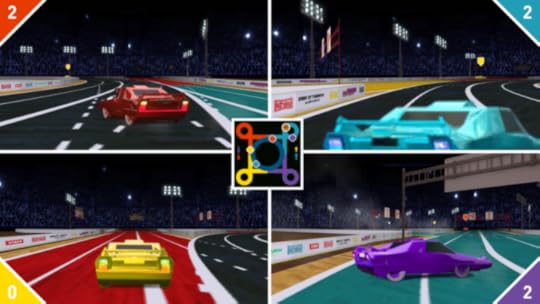
Kasketball requires a degree of strategy. Forging temporary alliances is encouraged as a way to get near a basket. This may not be the NBA’s version of basketball, but it is still something of a team sport. (Tough luck, Dion Waiters.) Score six points and you have the chance to exit the Kasketball court, which looks like a weird cross between an Olympic sprinting track and a NASCAR course, albeit with occasional basketball courts.
Now, we turn to the elephant in the room: isn't Kasketball just Rocket League but for basketball? Well, dear reader, it’s not like that would be a bad thing. Also, yes. But ThirtyThreeGames, which made Kasketball for the MadJam Seven Day Unity Jam, offers a better answer to this question:
The true story is even sadder. We came up with this idea in response to a jam theme, completely unaware of Rocket League. It wasn't until we were almost done that we saw RL and realized: we're forever destined to play far-second fiddle to that awesome game.
That would be a sad note on which to end this story, so let’s cheer things up a little. Kasketball addresses basketball’s biggest scourge: travelling. Travelling, for the NBA referees and players in the house who may have forgotten, is the act of walking around on a basketball court without dribbling. Once upon a time, travelling was against the rules in basketball. That time, as anyone who has watched a basketball game this millennium could tell you, was a very long time ago. Everyone now travels. If it's not going to be called, why wouldn’t you? Kasketball takes that logic to its ultimate conclusion. If dribbling while moving your feat in a walking-adjacent manner is no longer required, you should just hop in a car. Darryl Morey and Sam Hinkie better be listening!
The Coral Cave, and the art of turning Okinawa into a watercolor world
Where French and Japanese art wash into each other.
July 31, 2015
Who said P.T. was dead?
A corridor out of focus. Off-white walls, familiar photos, and a familiar bend up ahead. Clock reads 23:59. Like always. Yes—it’s that goddamned hallway again.
Hideo Kojima and Guillermo del Toro’s sinister Silent Hills teaser P.T. has been remade in Unity, charmingly called PuniTy. Its creator, Farhan Qureshi, only intended to render the eerie L-shaped passage for a 3D modelling workshop, but ended up creating a compact P.T. experience all of his own.
a towering figure standing crooked in the corridor
So many of the little details, from the twisted blister packs and miscellaneous pills littering the end table, to the lighting, depth-of-field, and slight camera wobble, are captured in PuniTy. Even Lisa is there—a towering figure standing crooked in the corridor. (Sadly, no Eraserhead baby.)
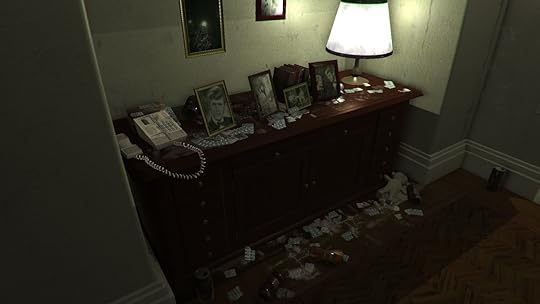
A staggering 104 hours over a four-week period went into this recreation. You can read all about the process on Qureshi’s blog, where he discusses everything from texturing Lisa’s ratty, blood-stained garment to animating cockroaches so they skitter around like real bugs. What a pleasant game P.T. was.
One of the most interesting parts of the process is how Qureshi layered in-camera filters to most accurately capture the look and feel of the original work. To folks familiar with game development, it might seem like an obvious design step, but for those who aren’t, it’s a good look into how even the most minute details can have an incredible impact on the feel of something.
it denies you that moment of relief
The visual effects added, in order, are: screen-space ambient occlusion, noise and grain, fisheye, chromatic abberation, global fog, screen-space antialiasing, dynamic depth-of-field, and flares. One step at a time, you can see what looks very much like a typical Unity prototype transform into a visually-loyal tribute to one of the greatest horror games this decade.
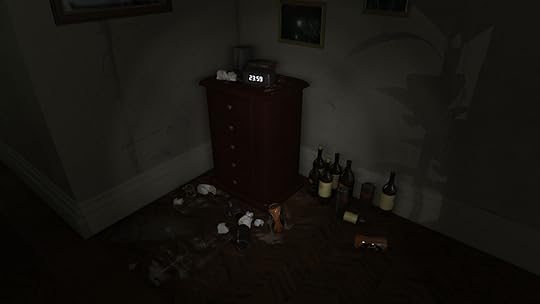
Making a game is hard work, though. There are no doorways to interact with in PuniTy as there were in the original, so the looping hallway trick manifests in a different way. This time, you’ll have to walk from one end of the L-shape to the other, and then turn back and do it again. It does detract from the feverish nightmare element of P.T. that made the original hallway so ominous, but for a fan creation made in a month, this is still incredible. In a way, the constant creeping back-and-forth between doors is even more exhausting than the original, because it denies you that moment of relief that came from unlocking the door and coming back out the other.
Maybe one day Konami will decide to put P.T. back on the PlayStation store. Maybe Kojima and del Toro will partner up for an entirely new horror game experience. But until then, videogames have its most dedicated and talented fans, putting in scores of sleepless nights just to recreate a single moment in that most menacing of hallways.
Download PuniTy for free on itch.io.
Digital typeface 83M80 is an attempt to claw back earlier internet eras
These are great times for the weird internet, which is a little strange because it’s all so respectable. Sure, there are still genuinely weird sites like oj.com, but they are weird precisely because they are retro. It’s probably for the best that we don’t live in the era of make-your-own-Geocities and frames, but what have we lost along the way and does it have any aesthetic value independent of our nostalgia?
83M80 — Letterpress in the Digital Era, a documentary by Gonzalo Hergueta and MRKA, attempts to address what has been lost in the move towards a more professionalized internet. Its focus is specifically on typefaces, but many of the points made in 83M80 could apply in other contexts. Through interviews with designers, it becomes clear that technological advances have paradoxically given designers greater control over their creative outputs while also creating greater pressures to achieve a perfected look. What’s the point of greater control if you can’t create glitches without it being interpreted as an act of dissent?
Things weren’t always this way. Indeed, 83M80 argues that most of the digital age has been characterized by a high tolerance for imperfections. It was not possible for early screens and processors to render typefaces as any more than rough forms, and so we accepted that. What else was there to do? Yet that acceptance was not usually reluctant. Early digital typefaces were appealing in their own strange ways. Sure, you may not have wanted to read War and Peace in their streaky glyphs, but they had a personality.
83M80, the typeface that accompanies the documentary, is an attempt to honor the early days of digital typography. It applies a variety of digital distortions to Bembo, a decades-old serif typeface. Some letters have the undulating forms you get from CRT TVs, their lines zig-zagging like a televised polygraph. Others take on the look of corrupted data, with chunks randomly appearing out of place or staggered. One of 83M80’s most compelling distortions is what its creators refer to as “low res,” a look reminiscent of the pixelated letterforms in early CRT videogames. These letters may be harder to read than more recent alternatives, but they more efficiently express context. That seems like a fair tradeoff.
You may not have wanted to read War and Peace in their streaky glyphs
Hergueta and MRKA have thus far used their typeface in exhibits after printing it with an old-school letterpress. The relief of the letterpress creates a strong and compelling contrast with the typeface’s digital influences. The pair has also made a beta version of the font’s digital edition available to a select few designers. 83M80 is unlikely to take over the world, but, in a sense, the various ideas it references once did.
Videogame generates worlds based on your webcam, horror ensues
We drive into the future using only our rearview mirror.
— Marshall McLuhan
Ian MacLarty's Reflections inspired one of those "whoa the future is here" moments in me. I remember years ago, I felt like I was in the goddamn Jetsons the first time I ever Skyped with a person half way across the world. I mean webcams—next you'll be telling me we can talk to people on our watches, too!
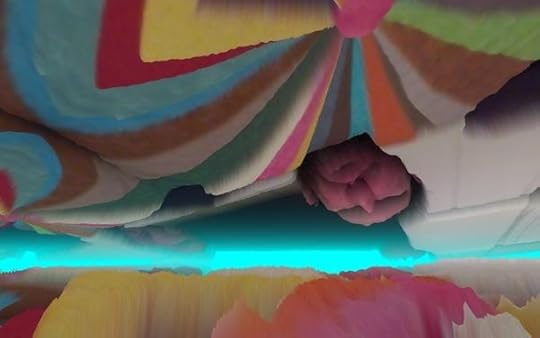
But Reflections is less cartoon sci-fi fantasy future, and more nightmarish surrealism made possible by technology. Like a mirror image of our mutated digital souls, Reflections generates a 3D landscape based on the visual feed from your webcam. A more humbling experience I have never known than to watch the contours of my face transform into the peaks and valleys of a virtual world.
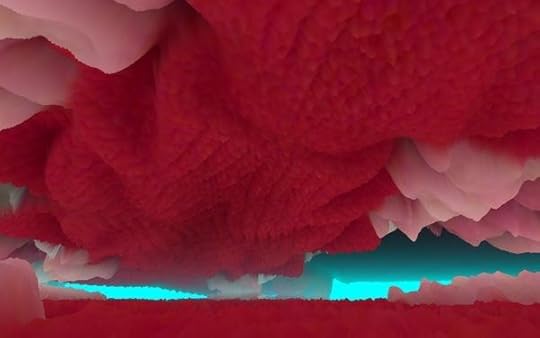
Standing on the flesh-colored ground, I looked up only to spot two pale, white suns high in the sky. Then they blinked. And I realized they were actually my eyeballs distorted into pitiless spheres of horror. When I shared a screenshot with the Kill Screen staff, one intern dubbed me "lumpy space Sauron."
one intern dubbed me "lumpy space Sauron"
But surreal doesn't even begin to cover an experience like Reflections. It doesn't just render a world from a static image of your face. It moves in response to your movements, a funhouse mirror that creates a distorted dimension instead of just an image. If you smile, the world suddenly splinters into a kaleidoscope of red gums and white spikes. If you try to get your dog in front of the webcam (as I did), he becomes Cloud Dog Jesus, with monuments springing forth to worship him above and below.
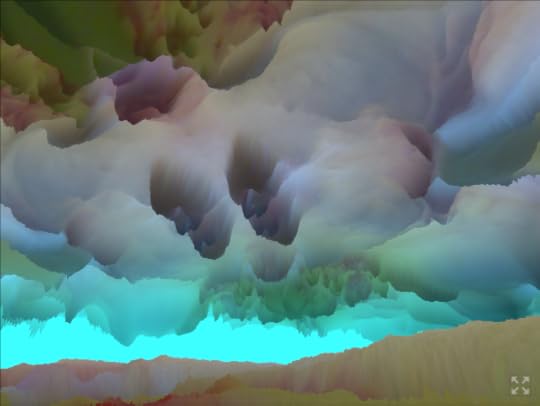
All I know is that if Reflections somehow gets VR support, brains might start imploding.
You can generate your own horror-filled dimensions on your browser for free here.
Hear the haunting industrial wail of Tangiers in its new trailer
Dark ambient meets Throbbing Gristle.
Kill Screen Magazine's Blog
- Kill Screen Magazine's profile
- 4 followers



